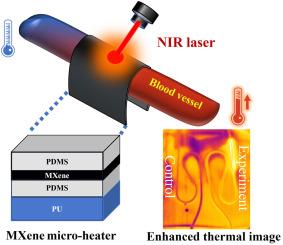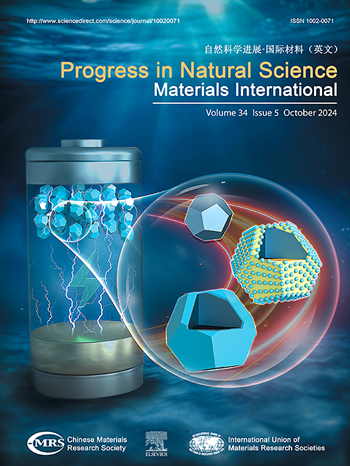MXene based flexible microheater for enhanced infrared imaging of cerebral blood flow
IF 4.8
2区 材料科学
Q2 MATERIALS SCIENCE, MULTIDISCIPLINARY
Progress in Natural Science: Materials International
Pub Date : 2024-10-01
DOI:10.1016/j.pnsc.2024.07.018
引用次数: 0
Abstract
Infrared thermography technology is a noninvasiveness and real-time imaging method, it has attracted enormous attentions for blood flow imaging. However, the implementation of infrared thermography technology is still limited by the poor imaging quality caused by the low temperature discrimination between the target blood vessel and background. Herein, we reported a flexible and low-cost MXene based photothermal microheater for enhancing the infrared imaging of blood flow. In the experiment, MXene films with specific thickness was prepared by vacuum filtering different concentrations of MXene colloidal solutions. Thereafter, the microheaters were fabricated by assembling the MXene films on the PU tape/PDMS substrate, and then sealed with another layer of pure PDMS film on the top of MXene film. The photothermal performance of the microheaters were evaluated by using an 808-nm laser as the exciting source. Experimental results show that the optimal microheater (MXene content: 17.5 mg) can reach a safe temperature of 41.5 °C with 43.9 s under the light irradiation of 100 mW·cm−2. Moreover, it can be stabilized at the equilibrium temperate for over 25 min. Finally, the above optimal microheater was used to accurately heat the simulated blood vessel. It shows that temperature difference of 3.3 °C can be induced between the heated blood vessel and environment. As a result, it significantly enhances the quality of the infrared imaging of the blood flow in the simulated vascular network.

用于增强脑血流红外成像的基于 MXene 的柔性微加热器
红外热成像技术是一种无创、实时的成像方法,在血流成像方面备受关注。然而,由于目标血管与背景之间的温度辨别度较低,导致成像质量不高,红外热成像技术的应用仍然受到限制。在此,我们报告了一种灵活且低成本的基于 MXene 的光热微加热器,用于增强血流的红外成像。实验中,通过真空过滤不同浓度的 MXene 胶体溶液制备了特定厚度的 MXene 薄膜。然后,将 MXene 薄膜组装在 PU 胶带/PDMS 衬底上,再在 MXene 薄膜上封上一层纯 PDMS 薄膜,就制成了微加热器。使用 808 纳米激光作为激发光源,对微加热器的光热性能进行了评估。实验结果表明,在 100 mW-cm-2 的光照射下,最佳微加热器(MXene 含量:17.5 mg)可在 43.9 秒内达到 41.5 °C 的安全温度。此外,它还能在平衡温度下稳定 25 分钟以上。最后,利用上述最佳微加热器对模拟血管进行了精确加热。结果表明,加热后的血管与环境之间可产生 3.3 °C 的温差。因此,它大大提高了模拟血管网络中血流的红外成像质量。
本文章由计算机程序翻译,如有差异,请以英文原文为准。
求助全文
约1分钟内获得全文
求助全文
来源期刊
CiteScore
8.60
自引率
2.10%
发文量
2812
审稿时长
49 days
期刊介绍:
Progress in Natural Science: Materials International provides scientists and engineers throughout the world with a central vehicle for the exchange and dissemination of basic theoretical studies and applied research of advanced materials. The emphasis is placed on original research, both analytical and experimental, which is of permanent interest to engineers and scientists, covering all aspects of new materials and technologies, such as, energy and environmental materials; advanced structural materials; advanced transportation materials, functional and electronic materials; nano-scale and amorphous materials; health and biological materials; materials modeling and simulation; materials characterization; and so on. The latest research achievements and innovative papers in basic theoretical studies and applied research of material science will be carefully selected and promptly reported. Thus, the aim of this Journal is to serve the global materials science and technology community with the latest research findings.
As a service to readers, an international bibliography of recent publications in advanced materials is published bimonthly.
文献相关原料
公司名称
产品信息
阿拉丁
MAX (Ti3AlC2)
阿拉丁
Lithium fluoride (LiF)

 求助内容:
求助内容: 应助结果提醒方式:
应助结果提醒方式:


